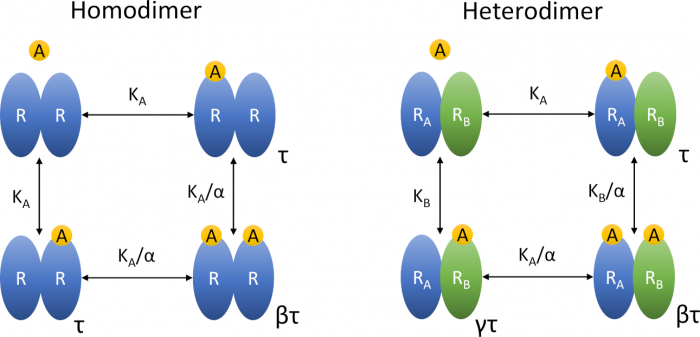 Left, homodimer consists of two identical receptors R binding one molecule of agonist A each with an equilibrium dissociation constant KA. Right, heterodimer consists of two different receptors R binding one molecule of agonist A each with an equilibrium
Left, homodimer consists of two identical receptors R binding one molecule of agonist A each with an equilibrium dissociation constant KA. Right, heterodimer consists of two different receptors R binding one molecule of agonist A each with an equilibrium
Insights into the operational model of agonism of receptor dimers
 Left, homodimer consists of two identical receptors R binding one molecule of agonist A each with an equilibrium dissociation constant KA. Right, heterodimer consists of two different receptors R binding one molecule of agonist A each with an equilibrium
Left, homodimer consists of two identical receptors R binding one molecule of agonist A each with an equilibrium dissociation constant KA. Right, heterodimer consists of two different receptors R binding one molecule of agonist A each with an equilibrium
Jakubík, J.; Randáková, A. Insights into the Operational Model of Agonism of Receptor Dimers. Expert Opin. Drug Discov. 2022, 17, 1181–1191, doi:10.1080/17460441.2023.2147502. Invited Review.
- The exact ranking of efficacies and potencies of agonists is indispensable in the discovery of new selective agonists.
- The operational model of agonism (OMA) is the current standard.
- Many receptors function as oligomers, requiring an extension of the classical OMA.
- Extension of OMA by slope factors gives simple equations of functional response that are easy to fit experimental data but results may be inaccurate.
- Extension of OMA by cooperativity factors gives accurate but complex equations of functional response.
- Extension of OMA by cooperativity factors should be preferred.
Introduction: Accurate ranking of efficacies and potencies of agonists is essential in the discovery of new selective agonists. For the purpose of system-independent ranking of agonists, the operational model of agonism (OMA) has become a standard. Many receptors function as oligomers which makes functional responses more complex, requiring an extension of the original OMA.
Areas covered: Explicit equations of the operational model of agonism of receptor dimers (OMARD) were derived. The OMARD can be applied to any receptor possessing two orthosteric sites. The behaviour of OMARD was analysed to demonstrate its complexity and relation to experimental data. Properties of OMARD and OMA equations were compared to demonstrate their pros and cons.
Expert opinion: Extension of OMA by slope factors gives simple equations of functional response that are easy to fit experimental data but results may be inaccurate. Also, such equations cannot accommodate bell-shaped curves. Explicit equations of OMARD give accurate results but are complex and tedious to fit experimental data. All operational models use inter-dependent parameters that are a hurdle in the fitting.
